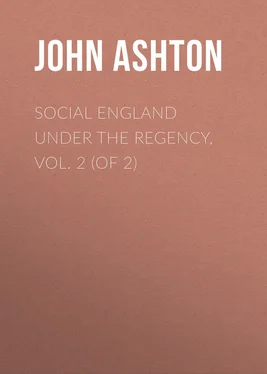John Ashton - Social England under the Regency, Vol. 2 (of 2)
Здесь есть возможность читать онлайн «John Ashton - Social England under the Regency, Vol. 2 (of 2)» — ознакомительный отрывок электронной книги совершенно бесплатно, а после прочтения отрывка купить полную версию. В некоторых случаях можно слушать аудио, скачать через торрент в формате fb2 и присутствует краткое содержание. Жанр: foreign_antique, foreign_prose, на английском языке. Описание произведения, (предисловие) а так же отзывы посетителей доступны на портале библиотеки ЛибКат.
- Название:Social England under the Regency, Vol. 2 (of 2)
- Автор:
- Жанр:
- Год:неизвестен
- ISBN:нет данных
- Рейтинг книги:3 / 5. Голосов: 1
-
Избранное:Добавить в избранное
- Отзывы:
-
Ваша оценка:
- 60
- 1
- 2
- 3
- 4
- 5
Social England under the Regency, Vol. 2 (of 2): краткое содержание, описание и аннотация
Предлагаем к чтению аннотацию, описание, краткое содержание или предисловие (зависит от того, что написал сам автор книги «Social England under the Regency, Vol. 2 (of 2)»). Если вы не нашли необходимую информацию о книге — напишите в комментариях, мы постараемся отыскать её.
Social England under the Regency, Vol. 2 (of 2) — читать онлайн ознакомительный отрывок
Ниже представлен текст книги, разбитый по страницам. Система сохранения места последней прочитанной страницы, позволяет с удобством читать онлайн бесплатно книгу «Social England under the Regency, Vol. 2 (of 2)», без необходимости каждый раз заново искать на чём Вы остановились. Поставьте закладку, и сможете в любой момент перейти на страницу, на которой закончили чтение.
Интервал:
Закладка:
The ratification of the Treaty of Peace with America arrived in London on the 13th of March, and created no comment. The main points in this treaty are contained in Article 1, of which the following is a portion: – "… All hostilities, both on sea and land, shall cease as soon as this Treaty shall have been ratified by both parties hereinafter mentioned. All territory, places, and possessions whatsoever, taken by either party from the other during the war, or which may be taken after the signing of this Treaty, excepting only the Islands hereinafter mentioned, shall be restored without delay, and without causing any destruction, or carrying away any of the artillery, or other public property, originally captured in the said forts or places, and which shall remain therein upon the exchange of the ratification of this Treaty, or any slaves, or other private property. And all archives, records, deeds, and papers, either of a public nature, or belonging to private persons, which, in the course of the war, may have fallen into the hands of the officers of either party, shall be, as far as practicable, forthwith restored, and delivered to the proper authorities and persons to whom they respectively belong."
Article 2 provides for cessation of hostilities.
Article 3 for the exchange of prisoners.
Article 4 deals with the Islands and boundaries in dispute, and appointed two Commissioners, one on each side, to settle them.
Articles 5, 6, 7, and 8 relate to the boundaries, and powers of the Commissioners.
Article 9 relates to making peace between the Indians, on both sides.
Article 10 provides for the joint abolition of the slave trade.
Why the American prisoners were not released, on receipt of the Ratification of the Treaty, I cannot say, but that they were not is evidenced by the fact that, on the 6th of April, those confined at Dartmoor attempted to escape; having armed themselves with knives, they attacked their guards, who in self-defence fired on them, killing seven of the prisoners, and wounding thirty-five. A coroner's jury brought in a verdict of "justifiable homicide."
The following story is best told by the Police Report: —
"Lambeth Police Office. 2 2 Lambeth Street, Whitechapel, removed to Arbour Square, Stepney, and now called the Thames Police Office.
Yesterday ( 5th April ) Margaret Moore was brought before Sir Daniel Williams, and underwent a second examination, charged with an attempt to steal the King's Crown from the Tower, on Friday, the 31st March last.
"Elizabeth Eloisa Stackling, Deputy Keeper of the regalia in the Tower, deposed, that about one o'clock in the afternoon mentioned, the prisoner came, and asked to see the regalia – the usual charge for such exhibition is eighteenpence, but the prisoner, having offered her a shilling, and she, supposing her, from her appearance, to be a soldier's wife, consented to take it. She proceeded to show her the regalia in the usual way, until she came to the last article, the Crown. This is contained in a case, and is never taken out; she opened the case, and held it with both hands, on the ledge of a table, except when she was obliged to disengage one hand, and point out particular jewels. She had just been describing the aqua-marine , a jewel of great value, when the prisoner stared, and in an instant thrust her hand through the centre bar of the railings, or grating placed there, and, seizing hold of the centre bow of the Crown, pulled, with great violence, to draw it forth.
"Witness put her hand at the top of the bow, and bottom of the Crown, to preserve it, while the prisoner kept struggling, with still greater violence, to get it away. The struggling continued for about five minutes, and she, at length, got the Crown from her grasp. She, then, put the Crown at a distance behind her, and instantly slipped the bolt of the entrance, secured the prisoner, and called for assistance. When help was obtained, she sent for the Governor, but the Ward-keeper having come in, a Constable was also sent for, who soon arrived, and took the prisoner into Custody. She was searched, and about £5 in money was found upon her; there were also some papers. In the struggle between the witness and the prisoner, there were two bows of the Crown broken from the socket; a string of pearls was also broken, which rolled upon the floor, some inside the railing, and some outside, where the prisoner was. They were subsequently picked up by the witness, assisted by the Governor.
"The prisoner, being called upon for her defence, said that she was a single woman, residing at No. 3, Union Street, Apollo Gardens; she was a milk woman, and had a girl of about thirteen years of age, her daughter, residing with her; she was a widow, her husband, who was a labouring man, had been dead about eleven years; is not acquainted with a soldier, nor was she ever in company with one, nor had she been to the Tower in her life before the day in question. Being asked by the magistrate why she came so far from home, she replied she very often went to Thames Street to buy salt herrings.
"Then, said the Magistrate, what induced you to go to the Tower?
" A. I went on Friday, purposely to see the lions, no one was with me – I then went to see the Crown.
" Q. How came you to snatch that article from the keeper?
" A. I thought it a pity that so valuable a thing should remain there, while half the nation was starving, for want of bread! I wished, also, at the time, to take the whole of what was there, and give it to the public!
" Q. Who told you to do this, or who was it put that good thought into your head?
" A. I had no adviser whatever.
"Jeremiah Brett, one of the Chief Constables, deposed to having taken the prisoner into custody. When he was conveying her away in the Coach, he asked her why she had made an attempt to seize, or lay hands on the Crown, and why she might not as well have laid hold of one of the lions? She replied – she was not such a fool, for she knew better than that.
"Upon being asked by the Magistrate to state a little more particularly who she was, she said she was a Welsh woman, from the county of Carmarthen, and had been brought up in the principles of the Church of England. About ten years ago she purchased some ground from Mr. Henry Hooper, of Apollo Gardens; and, about five years ago, built a small house, in which she lives, and which has already cost her £110. She was to have paid £150. Her other houses and property were stolen from her by ejectments, executions, &c., and her losses amounted, at least, to £500. She never had any idea of stealing the Crown, until she saw it, and was only impelled by the motive already stated. Does not recollect that she ever thought of providing for the poor until then.
"Mr. Swift, the Keeper of the Jewels in the Tower, was then called, but it was stated that he was out of town, and would not return before Saturday, or Monday.
"The evidence of this witness, however, being deemed necessary, the Prisoner was remanded for a final examination."
On Tuesday, April 11th, she was again examined, but a number of persons attended, who had known her for many years, and, as their unvarying testimony was that she was mentally deranged, she was discharged.
Whilst on the subject of the Regalia I may mention the following, which is taken from The Gentleman's Magazine , May 19, 1814: "An interesting discovery has lately been made by the Keeper of the Regalia in the Tower. In cleaning out some secret places in the Jewel Office, a Royal Sceptre was found, equalling in splendour, and in value, the others which are there exhibited. It is imagined, from the decayed state of its case, and the dust wherewith it was enveloped, that the Sceptre must have been thrown into that neglected corner, in the confusion of Blood's well-known attempt on the Crown Jewels, nearly a century and a half ago."
Читать дальшеИнтервал:
Закладка:
Похожие книги на «Social England under the Regency, Vol. 2 (of 2)»
Представляем Вашему вниманию похожие книги на «Social England under the Regency, Vol. 2 (of 2)» списком для выбора. Мы отобрали схожую по названию и смыслу литературу в надежде предоставить читателям больше вариантов отыскать новые, интересные, ещё непрочитанные произведения.
Обсуждение, отзывы о книге «Social England under the Regency, Vol. 2 (of 2)» и просто собственные мнения читателей. Оставьте ваши комментарии, напишите, что Вы думаете о произведении, его смысле или главных героях. Укажите что конкретно понравилось, а что нет, и почему Вы так считаете.












